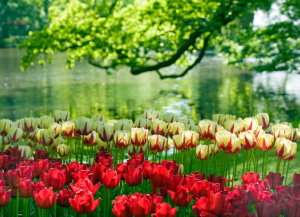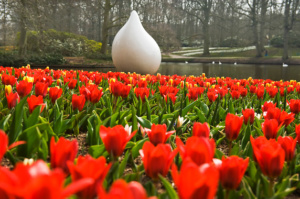Tulips are the world’s most famous flower bulbs. But why do so many people love this popular spring flower? There are many reasons including its beauty, versatility and rich history. Here are 10 interesting facts about tulips. Once you’ve read them, you’ll know why no garden is complete without these flower bulbs.
1. A worldwide demand
The Netherlands is the epicentre of tulip bulb production. This little country exports almost 2.5 billion tulip bulbs to other countries every year. Having the perfect soil for bulb production is what allows Dutch growers to achieve these numbers. And this is a good thing because people all over the world look forward to enjoying these colourful harbingers of spring.
2. Varieties
The 2.5 billion tulips bulbs that the Netherlands exports consist of 8,000 varieties. The 23 most important varieties make up 40 percent of the tulip bulb production and are sold in garden centres or used for flower production. Of all of them, the yellow ‘Strong Gold’ is by far the most popular tulip variety. ‘Leen van der Mark’, a red and white tulip, is in second place.
3. Tulip mania
It was in the early seventeenth century that a phenomenon known as ‘tulip mania’ broke out. In a very short time, tulip bulbs could become highly valuable items. They were sold on paper for huge sums while the bulb was often still in the ground. During this tulip craze, a single tulip bulb could be worth as much as an entire canalside property in Amsterdam.
4. Colourful
Tulips come in almost every colour of the rainbow: yellow, green, red, orange, purple, pink and even varieties with more than one colour. The only colours missing are blue and true black. Although some varieties approach black, they are actually a deep aubergine. ´Queen of Night´ comes closest, but even this tulip isn’t really black.
5. Groups
Did you know that tulips are categorised into fifteen different groups? This makes them easier to find among the huge assortment of tulips. Their flowering period and flower shape determine how they are grouped: there are single flowered, double flowered, fringed, lily flowered, species and parrot tulips as well as early-flowering and late-flowering tulips.
6. The joy of spring
Tulips mean springtime. After those cold dark winter months, these are the flowers that bring that longed-for cheerfulness to our streets and gardens. Their sparkling colours and opening flower buds are enough to make us smile. They start flowering in March. When you say tulips, everyone thinks of spring!
7. Breeding
Despite the many varieties of tulips we have, new ones are constantly being developed. This breeding involves crossing tulips with excellent characteristics to obtain new cultivars. It could still happen that a new colour or shape will be discovered – maybe even that coveted black tulip. But it will take twenty years before a new cultivar appears in garden centres.
8. Months of pleasure
If you choose your varieties wisely, you can enjoy tulips in your garden from early March to the end of May. To do this, plant tulips that have a range of flowering periods. You could also plant them in layers – a method known as lasagne planting. Once the tulips have finished flowering at the end of May, the perennials and annual bedding plants will start providing colour.
9. Like a botanical illustration
Did you know that some tulips will emerge and flower – and even increase in number – year after year? These are the species tulips and are sometimes referred to as ‘dwarf tulips’ because of their size and height as compared to other tulips. They are real early birds because most species tulips are the earliest of all the tulips to bloom. The most familiar of these are Tulipa sylvestris, T. tarda and T. turkestanica.
10. Pots
If you have a balcony or patio, you, too, can enjoy tulips. After all, these flower bulbs are perfect for planting in pots. It’s important, however, to use pots that are at least six times as tall as the flower bulb itself. This way, there will be a layer of soil both above and under the tulip bulbs which is three times the height of the bulbs. Also make sure that the pot has a hole at the bottom so that excess water can drain away.
Source: iBulb
Frequently Asked Questions (FAQs) about Tulips
1. What Are the Different Types of Tulips?
Tulips come in a variety of shapes and colors, making them a diverse and popular choice among gardeners. There are three main types of tulips: Darwin Hybrid Tulips, Triumph Tulips, and Fosteriana Tulips. Darwin Hybrids are known for their large, vibrant blooms and strong stems, making them ideal for cutting. Triumph Tulips offer a wide range of colors and are often used in formal garden displays. Fosteriana Tulips, also called Emperor Tulips, are known for their bold, early-blooming flowers in shades of red and yellow. These are just a few examples of the many tulip varieties available to add beauty to your garden.
2. When Should I Plant Tulip Bulbs?
The best time to plant tulip bulbs is in the fall, preferably about 6 to 8 weeks before the first hard frost in your area. This allows the bulbs to establish roots before winter sets in. Tulips thrive in well-drained soil and should be planted at a depth of about 6 to 8 inches, with the pointed end facing upwards. Be sure to choose a location with plenty of sunlight, as tulips require full sun to bloom their best. By planting in the fall, you’ll be rewarded with a stunning display of colorful tulips in the spring.
3. Can I Order Tulips from Your Online Store?
Yes, you can! Our online store offers a wide selection of tulip bulbs for purchase. We source high-quality bulbs to ensure the best possible results for your garden. You can browse various tulip varieties, colors, and quantities to suit your preferences. We also provide detailed planting instructions and care tips to help you achieve a successful tulip garden. Ordering from our online store is convenient and allows you to have these beautiful flowers delivered directly to your doorstep.
4. How Do I Care for Holland Tulips After They Bloom?
After tulips have bloomed, it’s important to care for them to ensure their health and future growth. Deadhead the spent flowers by removing the seed heads to prevent the plant from putting energy into seed production. Allow the foliage to yellow and wither naturally before cutting it back, as this allows the bulb to store energy for the next season. It’s a good idea to mark the location of your tulips, as the foliage will disappear completely, and you don’t want to accidentally disturb the bulbs when planting other flowers or performing garden maintenance.
5. Can Tulips Be Grown in Containers?
Yes, tulips can be successfully grown in containers, making them a versatile choice for both garden beds and patios. When planting tulips in pots or containers, use a well-draining potting mix and ensure the container has drainage holes. Plant the bulbs at the recommended depth, and place the containers in a sunny spot. Water them regularly but avoid waterlogging the soil. After they bloom, you can transplant the bulbs into the ground if you prefer, or store them in a cool, dry place until the next planting season. Container-grown tulips can add a burst of color and elegance to your outdoor space.
Published: 10.08.2020
